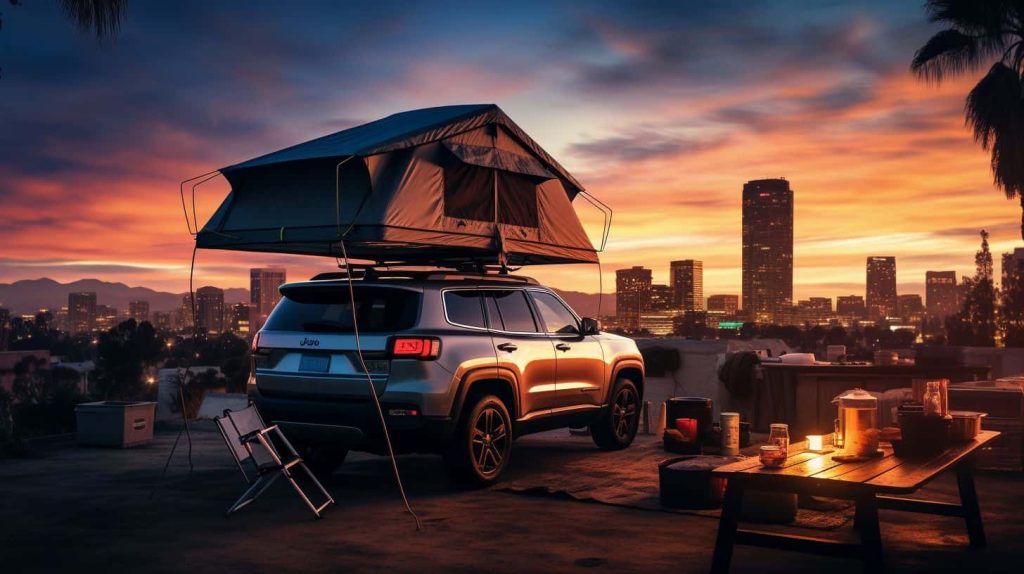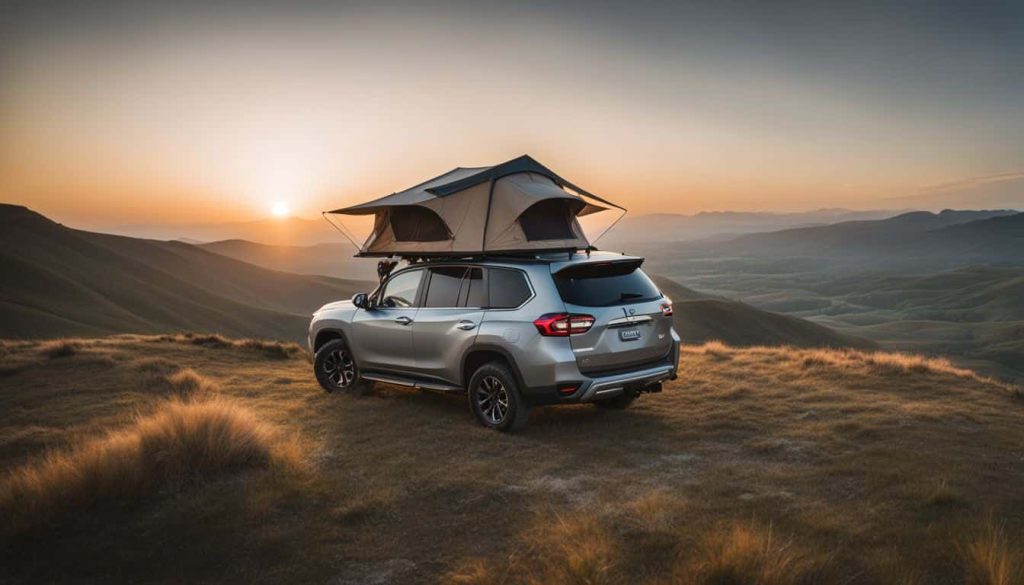
Thinking about installing a rooftop tent for your next camping adventure? It’s not as intimidating as it might sound. In this guide, we’ll walk you through the process of choosing a rooftop tent, and then explain step-by-step how to install a rooftop tent to transform your vehicle into a mobile campsite.
Key Takeaways
- Rooftop tents provide a safe, space – saving camping option by sitting on your vehicle’s roof rack and folding out into a bed.
- When choosing a rooftop tent, consider the type (hard shell or soft shell), extra features like LED lights or self-inflating mattresses, and ensure it fits your vehicle’s roof rack securely.
- Properly prepare your vehicle by checking its compatibility with the tent, installing crossbars or roof racks for support, unpacking and assembling the tent, assembling the mounting hardware, positioning the tent on the roof rack, attaching all hardware securely including the ladder, and adjusting everything for safety.
- Remember to follow safety tips such as checking weight capacity limits, parking on flat surfaces for stability, using three points of contact when entering/exiting the tent, and maintaining proper maintenance care to prolong its lifespan.
Understanding Rooftop Tents
Rooftop tents are like a treehouse on your car. They sit on the roof rack and fold out into a cozy bed when you need it. These tents provide safety as they keep us from bugs and animals.
There are many types of rooftop tents, some fold open like a book, others pop up or slide out. Some even have awnings for shade or rain cover and LED lights for night time use. Brands such as Skycamp make great rooftop tents that come with comfy foam mattresses inside.
How to Choose the Right Rooftop Tent for Your Car
Picking the best rooftop tent for your car is key. You need to think about some things.
- Know Your Vehicle’s Roof Capacity:
- Check your vehicle’s roof capacity, including its dynamic (while driving) and static (while parked) weight limits. Rooftop tents vary in weight, so ensure your vehicle can safely support the one you choose.
- Consider the Type of Camping You Do:
- Determine the type of camping you prefer. Are you into solo adventures, family trips, or overlanding expeditions? The number of occupants and your camping style will influence the size and type of rooftop tent you need.
- Hard Shell vs. Soft Shell:
- Decide between a hard shell and soft shell rooftop tent:
- Hard Shell: Are tough and made of materials like fiberglass, reinforced plastic, or aluminum. They’re easier to setup, often in less than 5-10 minutes with the click of a button, and provide more weather protection. They’re also heavier and more expensive.
- Soft Shell: Lightweight and made of fabric like poly-cotton canvas or high-denier polyester, this type is more budget-friendly, but may take longer to set up and may not be as weather-resistant.
- Decide between a hard shell and soft shell rooftop tent:
- Size and Capacity:
- Consider the sleeping capacity and available space in the tent. Ensure it comfortably accommodates the number of people you plan to camp with. Some tents also have annexes or awnings for additional space.
- Material and Weather Resistance:
- Check the tent’s fabric material. Quality poly-cotton canvas or durable polyester is ideal for soft shell tents. For hard shell tents, assess the materials used in both the shell and fabric portions. Ensure the tent is weather-resistant and can handle your intended camping conditions.
- Ease of Setup:
- Evaluate how easy it is to set up and take down the tent. Quick and hassle-free setup is a valuable feature, especially if you plan to move frequently.
- Aerodynamics and Fuel Efficiency:
- Consider how the rooftop tent may affect your vehicle’s aerodynamics and fuel efficiency. Some rooftop tents are designed to minimize wind resistance.
- Mounting System Compatibility:
- Ensure the rooftop tent is compatible with your vehicle’s roof rack or mounting system. Check the required mounting hardware and compatibility with your specific vehicle make and model.
- Weight:
- Pay attention to the weight of the rooftop tent. A heavier tent may affect your vehicle’s handling and fuel efficiency. Ensure it falls within your vehicle’s weight capacity.
- Ventilation and Insulation:
- Look for tents with proper ventilation to reduce condensation and improve comfort. Some tents come with additional insulation for colder climates.
- Additional Features:
- Consider any extra tent features, like LED lights, built-in mattresses, interior pockets, windows, and access options.
- User Reviews and Recommendations:
- Read reviews and seek recommendations from fellow campers who have experience with the specific rooftop tent models you’re interested in. Their insights can be valuable.
- Budget:
- Determine your budget and explore rooftop tents within your price range. Keep in mind that quality and features often correlate with the price.
- Warranty and Support:
- Check the manufacturer’s warranty and customer support options. A good warranty can provide peace of mind for your investment.
- 【Complete accessories / travel is more convenient!】Newly upgraded car rooftop tent add 2 luggage pole, LED light strips, zipper for YKK, 5 cm thick mattress and retractable 2.3m ladder. The…
- 【Easy to set up a tent in seconds】 Hard shell rooftop tent is equipped with air pressure rods, which can easily pop up or store the roof tent within 10 seconds, easy and convenient! Overland rtt…
- 【Aluminum Alloy Shell + Stainless Steel Gas Bar】The car camping tent is designed with high-quality aluminum, ABS 5.5mm hard shell, installation kit and fabric, metal shell rtt can resist level 6…
- 【Top configuration 3-layer mattress】 Roof rack tent have three mattresses: 5cm non deformable soft mattress providing you with high-quality and comfortable rest and sleep; condensation mat to…
- 【Spacious / Storage Space】 Roof top tents can accommodate two adults and one child. And with 10 storage bags for daily necessities and 2 waterproof storage bags for shoes!
- 【Easy Open an Close】 Car rooftop tent with air pressure poles and pre-assembled components, setting up the hard shell roof tent is a breeze. Within 5 seconds, you can pop it up or put it away…
- 【All-Season Versatility】 Designed to withstand various weather conditions. Its waterproof fabric and shell, with a W/R 5000 rating, ensure excellent water resistance. The sun protection fabric and…
- 【Premium Three-Layer Mattress】 Experience ultimate comfort with the top configuration three-layer mattress. It consists of a 5cm non-deformable soft mattress that offers high-quality rest and…
- 【Spacious Design with Ample Storage】 The roof rack tent provides ample space to accommodate two adults and one child, allowing for a comfortable camping experience. Furthermore, truck bed tent…
- 【Full Overland Equipment for Car Camper】 BAMCAR roof top tent hardshell includes 3 mattress, zipper for YKK, mesh window, 10 storage bag, and 2 waterproof shoe bag. Overload equipment also…
- Standard size tent (sleeps 2-3) with high-density 92″ x 55″ foam double/full mattress and 661 lb. max load
- 600D heavy-duty waterproof top and rain fly; sunroof; side windows with mosquito netting; anodized aluminum tent frame poles; telescopic ladder; interior LED strips and many more features
- Easy to set up and take down; heavy duty PVC cover keeps tent dry and free from UV rays when not in use
- Smittybilt Tent Annex (sold separately #2788) with removeable floor can be attached with heavy duty zippers for privacy
- Tent also available in Size XL (sleeps 3-4 #2773). Ladder extension also available (#2785).Ladder capacity:265 lbs
- 【2-3 People Rooftop Tent】 Provides you with a home-like feeling while traveling! The Naturnest rooftop tent tent camping adopts a rectangular design, giving you the feeling of a bedroom. 2024…
- 【Easy To Set Up】 The pop up roof tent is designed with stainless steel support rod. It only takes 1 minute to set up the car top tent. The support rod are equipped with protective covers to ensure…
- 【All weather 4 Season Rooftop Tent】100% waterproof, 100% blackout, UPF 50+. The Hardshell rooftop tent is made of waterproof 305G thick Polyester cloth and black rubber sun protection technology….
- 【Fuel efficient & sturdy & safe】The ABS hard shell rooftop tent adopts a streamlined design to reduce wind resistance and reduce fuel consumption. Durable and safe, can withstand level 6 wind…
- 【Comfortable Mattress & Bottom Oak Board】 The Naturenest roof top tent is equipped with a 5cm non-deformable soft mattress, providing a high-quality and comfortable sleeping environment; the…
- QUALITY AND DURABILITY ARE ABOVE ALL ELSE: The TOPBEE rooftop tent is made of military grade aluminum and durable 800D thick Oxford cloth, which has good durability and sturdiness. Every rooftop tent…
- EASY TO INSTALL:Roof top tent comes with stainless steel air pressure poles and pre-assembled components with clear and concise instructions.Simply install the screws using the complimentary thorn…
- THREE LAYERS OF MATTRESS: ① 1.2inch non-deforming soft mattress, providing you with comfortable rest and sleep;② condensation pad, preventing air pressure and temperature difference between day…
- A FORTRESS AGAINST WIND AND RAIN: The fabric of the hardshell rooftop tent is made of heavy-duty tear resistant fabric, ensuring durability in harsh weather conditions. Coated with PU3000 waterproof…
- A FORTRESS AGAINST SUN AND SNOW: The hard shell roof top tents’s unique fabric blocks harmful UV rays, preventing internal sunburn and heat buildup by dramatically reducing sun exposure. The sturdy…
- 【Easy to set up tent in seconds】 Car camping tent uses high-quality ABS and air pressure poles. You can easily pop up or stow the roof tent within 30 seconds, which is easy and convenient!…
- 【Sunscreen/Waterproof/Breathable】 Nature nest roof top tent with fabric is made of waterproof-coated polyester yarn fabric, with waterproof glue at the seams, W/R 5000, and high-quality sealing…
- 【Top configuration three-layer mattress】 Roof top tent hardshell has three layers of mattress: 3.5cm memory foam mattress, providing you with high-quality and comfortable rest and sleep; 0.5cm…
- 【Capacity and overland equipment】 Camping tent attached to suv can accommodate 2 adults and 1 child. Car tents are equipped with 2 LED light strips and daily necessities storage bags inside….
- 【Service & Warranty】 Naturnest always provides you with high-quality service. If you have any questions after receiving the pop up car tent, you can contact me at any time and I will solve it for…
- Features: Marine Grade 600D Rip-Stop Polyester Water Proof Body, 420D Polyester Oxford Waterproof Rain Fly, 110g Fade-less Gaze Breathable Windows, High Density Foam Mattress with Cover, Insulated…
- What’s Included: Insulated Base With Stainless Hinges and Anodized Aluminum Poles, Khaki Tent Body, Coffee Rain Fly, Foam Mattress With Cotton Cover, Window Rods, Adjustable Ladder 81”, Aluminum…
- Fitment: Anything with a factory or aftermarket roof rack. Please confirm rack weight capacity prior if you’re unsure.
- Installation: Requires no drilling or modification to your vehicle if equipped with factory or aftermarket roof rack.
- Open size 122″” W x 76″” L x 51″” H
- Sleeps 3-4
- Bed size: King, 92.5″” x 74.8″”
- Gray tent body with light gray rainfly
- (1-3/16″”) 2.5cm aluminum/polyurethane sandwich base
- 【Easy to set up a tent in seconds】 Hard shell rooftop tent is equipped with air pressure rods, which can easily pop up or store the roof tent within 10 seconds, easy and convenient!
- 【Aluminum Alloy Shell + Stainless Steel Gas Bar】The car camping tent is designed with high-quality aluminum, ABS 5.5mm hard shell, installation kit and fabric, which can resist level 6 wind. The…
- 【Spacious / Storage Space】 Roof top tents can accommodate two adults and one child. And with 10 storage bags for daily necessities and 2 waterproof storage bags for shoes!
- 【Available in all seasons】 Waterproof, windproof and sunscreen, car tents suitable for any season, not afraid of heat and winter! The fabric of the camping tent attached to suv is polyester cloth…
- 【Full camping equipment】 Car rooftop tent is equipped with 2 luggage rails (installed on the top of the tent), add LED light strips, 5 cm thick mattress, moisture-proof pad, retractable 2.3m…
- Premium Material: Designed to be fully weatherproof, the main body of the rooftop tent is made of high-density oxford cloth and the outer cover is made of 420D durable oxford cloth. With waterproof,…
- Sunroof Design: As a special point, the top of the roof tent is designed as a full-view sunroof, which will bring more natural light into the interior. During the day, just enjoy the wind and sunshine…
- Extremely Easy Assembly: Different from other camping tents, this roof top tent you receive will have tracks already installed, and can be installed on the roof or disassembled in a short time. Spend…
- Huge Interior: Compact and lightweight when closed, the car tent will become a spacious rooftop home when open. Built with comfortable 2″ thick foam mattress, the roof top tent has plenty of space…
- Wide Adaptation: Our stylish roof tent is fit for most 4WD roof racks and trailer mounts, and the included telescopic ladder will make it easy to access the tent. If you have any questions about the…
How to Preparing Your Car for a Rooftop Tent
To ensure a successful rooftop tent installation, it’s important to properly prepare your vehicle. This involves checking the compatibility of your vehicle with the tent, as well as installing crossbars or roof racks for proper support.
- Check Vehicle Roof Capacity:
- Refer to your vehicle’s manual or contact the manufacturer to determine the dynamic (while driving) and static (while parked) weight capacity of your roof. Ensure that the roof can safely support the weight of both the rooftop tent and any occupants.
- Install Roof Rack or Roof Bars:
- If your vehicle does not have a roof rack or roof bars, you’ll need to install them first.
- Ensure that the rack or bars are made for carrying a rooftop tent and are securely attached to your vehicle.
- Select the Rooftop Tent Location:
- Choose the location on your vehicle’s roof where you want to install the rooftop tent. Ensure that it’s centered and aligned properly.
- Gather Installation Hardware:
- Collect all the necessary hardware and components provided with your rooftop tent. This typically includes brackets, bolts, nuts, and mounting plates. Make sure you have all the required tools, such as wrenches and screwdrivers.
- Inspect the Roof Rack or Bars:
- Examine the roof rack or bars for any damage or signs of wear. Replace any worn or damaged components to ensure a secure installation.
- Position Mounting Brackets:
- Attach the mounting brackets provided with your rooftop tent to the roof rack or bars. Ensure that the brackets are positioned correctly according to the tent manufacturer’s instructions.
- Assemble the Rooftop Tent:
- Follow the assembly instructions provided with your rooftop tent to put together the tent structure. This may involve attaching the tent’s base to the mounting brackets on your vehicle.
- Secure the Tent to the Brackets:
- Once the tent is assembled, carefully position it on the mounting brackets attached to your vehicle’s roof rack or bars. Ensure that the tent aligns with the brackets and the holes for mounting hardware.
- Attach and Tighten Bolts:
- Insert bolts through the mounting holes in the rooftop tent and brackets. Securely fasten nuts to the bolts and use the appropriate tools to tighten them. Follow the manufacturer’s torque specifications for proper tension.
- Double-Check Fastenings:
- After securing the rooftop tent, double-check all fastenings and connections to ensure they are tightened properly. Loose hardware can lead to instability during travel.
- Test the Setup:
- Before your first camping trip, perform a test setup of the rooftop tent to ensure that it opens, closes, and latches securely. Verify that the tent’s setup does not interfere with any other vehicle components, such as antennas or sunroofs.
- Perform a Weight Distribution Test:
- To assess the balance and weight distribution of your rooftop tent, park your vehicle on level ground and carefully load the tent with gear and occupants as you would during camping. Ensure that the weight is evenly distributed and within the roof capacity limits.
- Regular Maintenance:
- Periodically inspect the rooftop tent and mounting hardware for signs of wear, rust, or damage. Maintain your roof rack or bars to prevent corrosion. Lubricate moving parts as recommended by the tent manufacturer.
The Installation Process
To install a rooftop tent, start by unpacking and assembling the tent itself. Then, assemble the mounting hardware and position the tent on your vehicle’s roof rack. Attach the mounting hardware securely and install the ladder for easy access.
Unpacking and Assembling the Rooftop Tent
To install a rooftop tent, you will need to unpack and assemble it. Here are the steps to do it:
- Start by unpacking the rooftop tent from its packaging.
- Lay out all the components and make sure everything is included.
- Follow the instructions provided to assemble the tent frame.
- Connect the poles and secure them according to the instructions.
- Attach any additional accessories, such as an awning or side panels, if desired.
- Once the tent frame is assembled, locate the mounting hardware.
- Attach the mounting hardware to the designated points on the tent frame.
- Position the rooftop tent on top of your vehicle’s roof rack.
- Use the mounting hardware to secure the tent to your roof rack.
- Ensure that all bolts and screws are tightened properly for a secure installation.
Assembling the Mounting Hardware
To assemble the mounting hardware for your rooftop tent, follow these steps:
- Lay out all the components of the mounting hardware kit.
- Attach the metal brackets to the base of the tent using the provided screws.
- Position the mounting plates on top of the roof rack crossbars.
- Align the holes on the mounting plates with the holes in the roof rack crossbars.
- Insert and tighten the bolts through the holes to secure the mounting plates to the crossbars.
- Use a wrench or socket set to tighten the bolts securely.
- Double – check that all bolts are tightened properly to ensure stability and safety.
Positioning the Tent on the Roof Rack
To position the tent on the roof rack, follow these steps:
- Check the weight capacities of your roof rack and ensure it can support the rooftop tent.
- Place the tent on top of the roof rack, making sure it is centered and aligned with the vehicle.
- Secure the tent to the roof rack using the mounting brackets provided.
- Use a measuring tape to ensure that the tent is evenly positioned on both sides of the roof rack.
- Double – check that all bolts and screws are tightened properly to prevent any movement or wobbling while driving.
- Test the stability of the setup by gently shaking the tent to make sure it is securely attached.
- Once you are satisfied with the positioning, move on to attaching other components such as ladders and awnings if needed.
Attaching the Mounting Hardware
To attach the mounting hardware for your rooftop tent, follow these steps:
- Ensure you have all the necessary mounting hardware, including brackets and screws.
- Position the brackets on the bottom of the tent base, making sure they align with the mounting points on the roof rack.
- Use a screwdriver or drill to securely fasten the brackets to the tent base.
- Lift the assembled tent onto your vehicle’s roof rack, making sure it is centered and aligned with the mounting points.
- Securely attach the brackets to the roof rack using screws or bolts, ensuring they are tightened properly.
- Double – check that all connections are secure and stable before moving on to other steps in the installation process.
Installing the Ladder
To install the ladder for your rooftop tent, follow these steps:
- Attach the ladder brackets to the side of the tent.
- Position the ladder at the desired height and angle.
- Secure the ladder in place using the provided bolts or clamps.
- Test the stability of the ladder by gently shaking it.
- Ensure that the ladder is securely attached and can support your weight.
Securing and Adjusting the Tent
To ensure a secure installation and proper usage of your rooftop tent, follow these steps:
- Attach the tent securely to the roof rack or crossbars using the mounting hardware provided.
- Make sure the tent is centered and level on the roof rack.
- Tighten all bolts and screws to prevent any movement during travel.
- Adjust the ladder to the appropriate height for easy access.
- Double – check that all straps, buckles, and zippers are properly fastened before use.
Safety Tips for Using a Rooftop Tent
- Make sure to properly install the rooftop tent and check the weight capacity of your roof rack or cross bars.
- Ensure that the rooftop tent fits securely on your vehicle and does not block any doors or windows.
- Use a clean vehicle for installation to avoid debris causing damage to the tent.
- Follow the instructions and guidelines provided by the manufacturer for safe installation and use of the rooftop tent.
- Park on a flat surface when using a rooftop tent to ensure stability.
- Respect weight limitations and do not overload your vehicle with excessive weight, including the tent and additional structures.
- Be cautious when entering or exiting the rooftop tent, using the ladder or steps provided, and always maintain three points of contact.
Rooftop Tent Manufacturer Websites
- Tepui Tents: Tepui Tents Website
- iKamper: iKamper Website
- Thule Tepui: Thule Tepui Website
- Roofnest: Roofnest Website
- Front Runner Outfitters: Front Runner Outfitters Website
- CVT (Cascadia Vehicle Tents): CVT Website
- GFC (Go Fast Campers): GFC Website
- Smittybilt: Smittybilt Overlander Roof Top Tent
- Eezi-Awn: Eezi-Awn Website
- James Baroud: James Baroud Website
- Roam Adventure Co.: Roam Adventure Co. Website
- 23Zero: 23Zero Website
- Free Spirit Recreation: Free Spirit Recreation Website
- Bigfoot Tents: Bigfoot Tents Website
- Camp King Industries: Camp King Industries Website
- Gordigear: Gordigear Website
- Roof Top Tent Camping: Roof Top Tent Camping Website
Maintenance and Care for Your Rooftop Tent
Maintaining and caring for your rooftop tent is important to ensure its longevity and functionality. Follow these steps for proper maintenance:.
- Regularly inspect the tent for any damage or wear.
- Clean the tent using mild soap and water, focusing on removing dirt, stains, and debris.
- Lubricate pivot points and zippers with a silicone-based lubricant to prevent rusting and ensure smooth operation.
- Check the tension of straps and ropes, tightening them if necessary.
- Use UV-resistant products to protect the fabric from sun damage.
- Store the tent in a dry and well-ventilated area when not in use to prevent mold or mildew growth.
- Avoid storing heavy items on top of your rooftop tent as it can cause unnecessary strain on the structure.
- Follow manufacturer’s instructions for specific care guidelines.
Proper maintenance will help prolong the lifespan of your rooftop tent, ensuring it remains a reliable and comfortable camping option. Remember to follow the manufacturer’s instructions to keep your warranty valid.
Conclusion
Installing a rooftop tent is a straightforward process that most people can do themselves. By choosing the right tent and preparing your vehicle properly, you’ll be ready to go on your next camping adventure in no time.
With some basic tools and careful installation, you’ll have a cozy spot to sleep under the stars right on top of your vehicle. So get out there and enjoy the great outdoors with your new rooftop tent!
FAQs
1. How can I install a rooftop tent like Skycamp Series on my 4Runner?
You can fix the Skycamp series or other roof top tents to 3rd and 4th generation 4Runners with mounting brackets. Fit these on existing factory mounting points, tracks, or any raised side rails present on your 4Runner.
2. Can I use tools from McMaster-Carr to put up a rooftop tent?
Yes! Tools from McMaster-Carr such as U-bolts and Unistrut/Channel struts are perfect for fixing aluminum rails or ARB L-brackets required for installing roof top tents.
3. Will fitting a BDV Series impact the weight of my car?
While some load is added by the BDV Series or other roof top tent accessories, it does not exceed the static weight capacity and stays within dynamic weight capacity of your car’s factory roof rack.
4. Are there extras that come with rooftop tents like X-Cover 2.0 series?
Yes! The X-cover 2.0 series includes LED light strips, USB cords to power banks for charging devices and handy shoe bags among others!
5.Should I worry about bad weather when camping with FreeSpirit Evolution RTT fitted?
The FreeSpirit Evolution RTT comes fully equipped with UV protection and water resistance features so you’ll be well covered against rain or sun!
6.What should I consider before picking an after-market roof rack for my Second Generation Nissan Xterra?
Pick an after-market roof rack based on factors such as door clearance, strut channel low-profile options, and fitment compatibility with popular brands such as Prinsu or Front Runner Outfitters.







